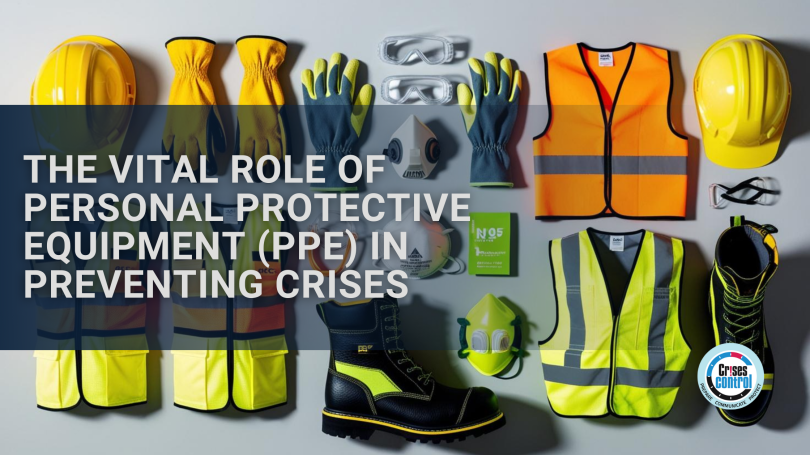In the world of crisis management, preparedness is paramount. While the term “crisis” often conjures images of natural disasters or cybersecurity breaches, it encompasses a broad spectrum of unexpected challenges. Among the most fundamental elements of crisis preparedness is the use of Personal Protective Equipment (PPE). In this blog, we delve into the vital role that Personal Protective Equipment plays in preventing and mitigating crises across various sectors. Join us as we explore the nuances of crisis prevention through the lens of Personal Protective Equipment.
Understanding the Basics: What is Personal Protective Equipment?
Personal Protective Equipment, encompasses a wide range of equipment and gear designed to safeguard individuals from various workplace hazards. From hard hats to hazmat suits, Personal Protective Equipment serves as the first line of defense against threats such as physical injuries, chemical exposures, biological agents, and more.
Key Personal Protective Equipment (PPE) Components
Personal Protective Equipment consists of several key components, including protective clothing, helmets, gloves, eye protection, respiratory protection, and safety footwear. Each component serves a specific purpose in shielding workers from potential harm, making them indispensable in crisis-prone environments.
The Crucial Role of PPE in Crisis Prevention
Workplace Safety and Injury Prevention
In any organization, the safety and well-being of employees are paramount. Properly selected and utilised Personal Protective Equipment significantly reduces the risk of injuries, ensuring that your workforce remains healthy and productive. Preventing accidents through PPE not only safeguards employees but also mitigates the operational disruptions crises can cause.
Crisis Resilience in the Face of Natural Disasters
Natural disasters, such as earthquakes, floods, and wildfires, can strike without warning. Personal Protective Equipment plays a critical role in preparing your workforce to respond effectively during and after such events. For instance, protective gear like helmets and sturdy footwear can be lifesavers when navigating unstable terrain in the aftermath of a disaster.
Health Pandemics and Biological Threats
The global COVID-19 pandemic brought the importance of Personal Protective Equipment to the forefront. Beyond medical settings, businesses and institutions worldwide adopted Personal Protective Equipment, including masks and face shields, to protect employees and customers. This proactive approach helped curb the spread of the virus and kept operations running as smoothly as possible.
Crisis Management and Business Continuity
Personal Protective Equipment is a linchpin in ensuring business continuity during crises. By equipping your workforce with the right gear, you empower them to handle emergencies efficiently. This can range from fire-resistant clothing for industrial settings to safety goggles for chemical spill containment.
Selecting the Right PPE for Your Organization
Assessing Risk and Hazards
To determine the most suitable Personal Protective Equipment for your organization, conduct a thorough risk assessment. Identify potential hazards and their severity, whether they are physical, chemical, or biological. This assessment will guide your Personal Protective Equipment selection process.
Training and Education
Purchasing Personal Protective Equipment is just the beginning. Proper training and education on the correct usage and maintenance of Personal Protective Equipment are equally essential. An informed workforce is better equipped to prevent crises effectively.
PPE and Crises Communication Technology
Crises often require swift, coordinated efforts across an organization. Integrated technology solutions, like the one offered by Crises Control, bridge the gap between Personal Protective Equipment wearers and crisis management teams. Through real-time communication platforms, wearers can relay critical information directly to response teams, enhancing situational awareness and expediting responses. This seamless coordination minimizes the time between detecting a potential crisis and executing a response, reducing its impact.
Technology has also streamlined the management of Personal Protective Equipment, ensuring that it remains effective and readily available. Automated systems can track Personal Protective Equipment usage, schedule maintenance, and manage inventory levels. This proactive approach guarantees that workers always have access to properly functioning Personal Protective Equipment, reducing the likelihood of equipment-related crises.
As technology continues to advance, the integration of Personal Protective Equipmentand tech-driven solutions becomes increasingly crucial in the realm of crisis prevention. It empowers organizations to proactively protect their workforce, enhance their crisis management capabilities, and ultimately fortify their resilience.
Conclusion
As we’ve explored, Personal Protective Equipment is not merely gear; it’s a shield against crises. From safeguarding lives to ensuring business continuity, Personal Protective Equipment plays a pivotal role in preventing and managing crises.
Incorporating technology into your crisis prevention strategy is a strategic decision that can yield significant dividends. To explore how Crises Control leverages technology to complement Personal Protective Equipment in crisis preparedness, request a live demo or reach out to our experts. By embracing this holistic approach, you not only protect lives and assets but also future-proof your organization in an ever-evolving landscape of crises and challenges.







